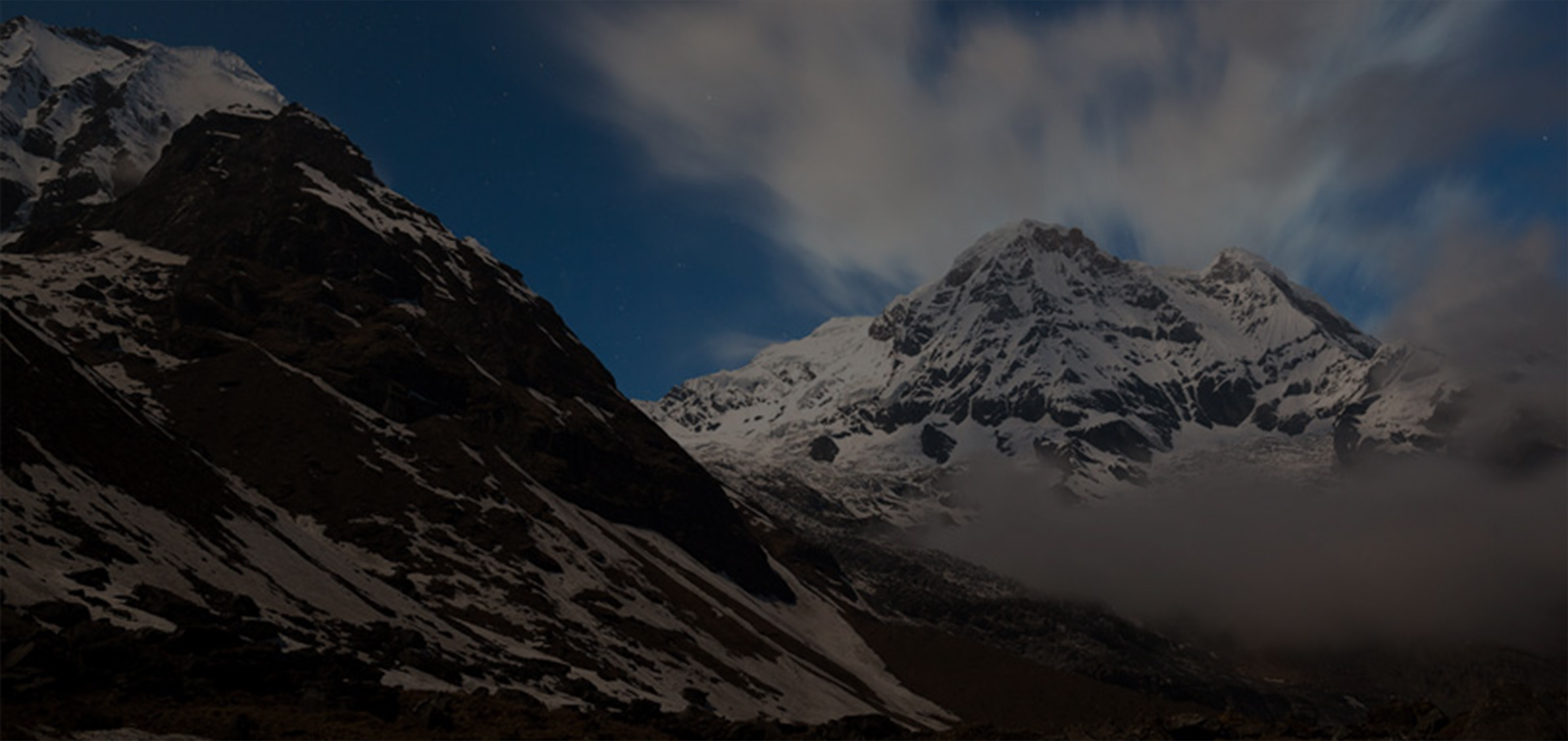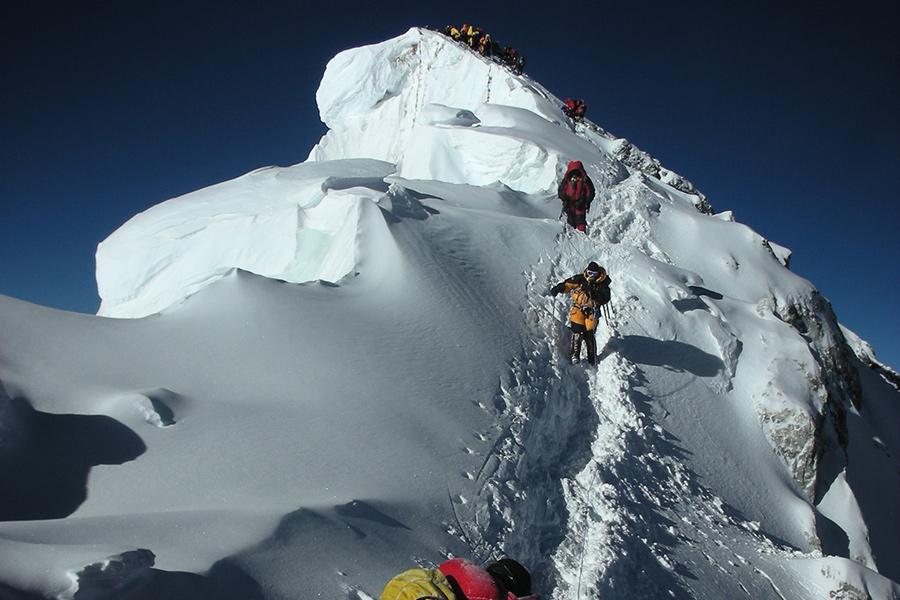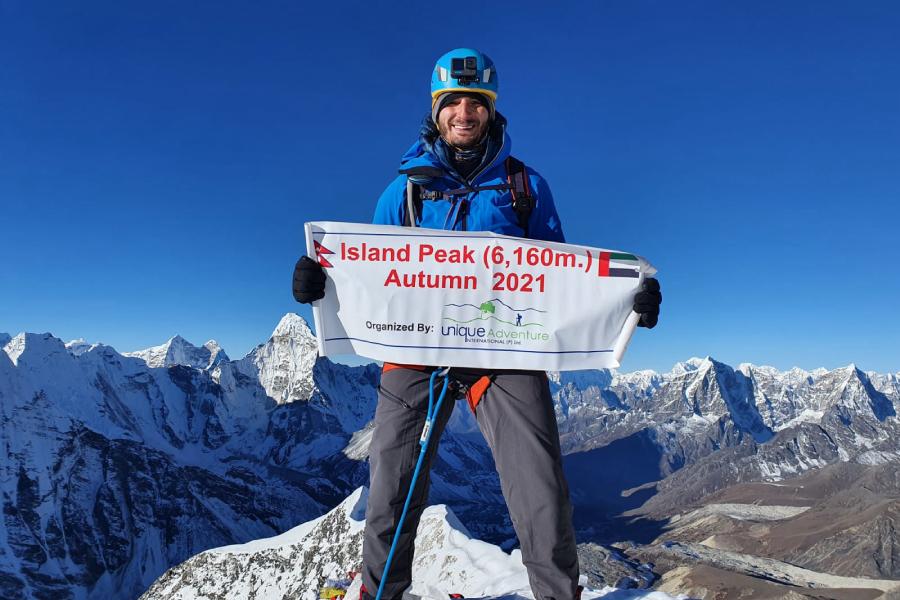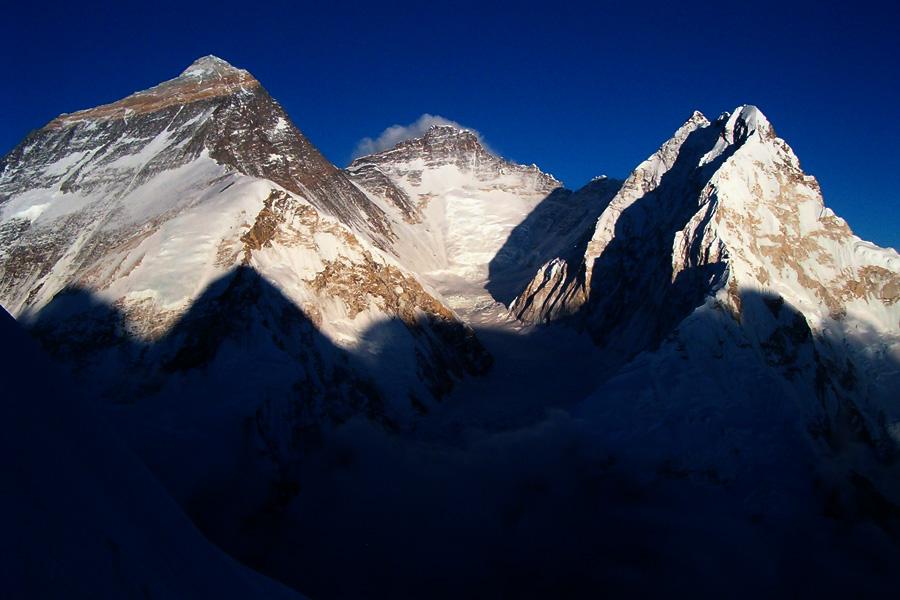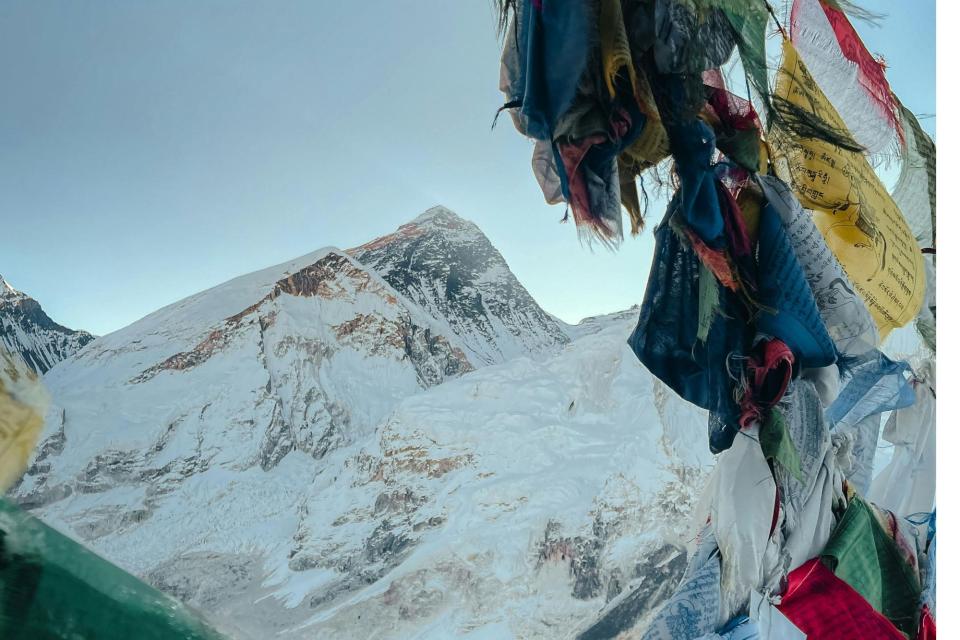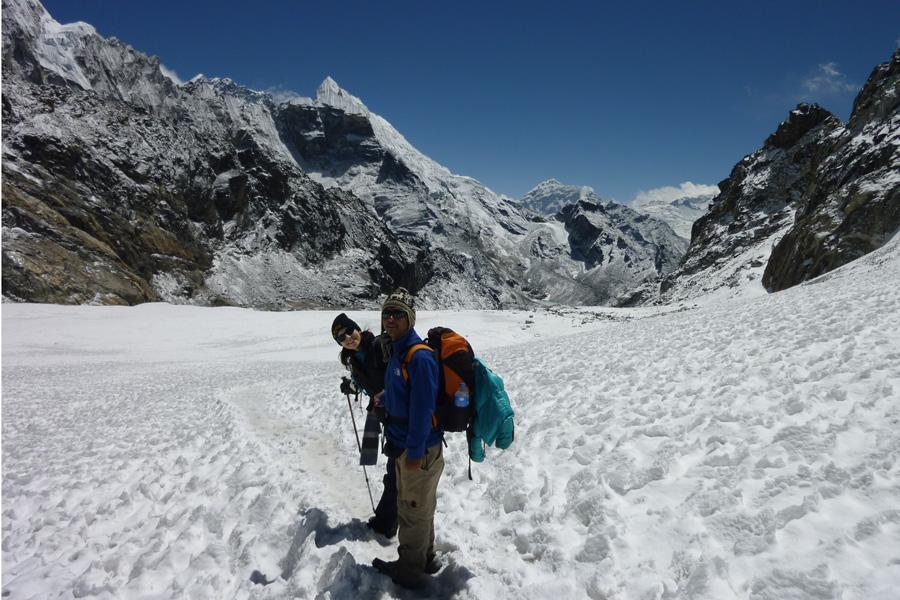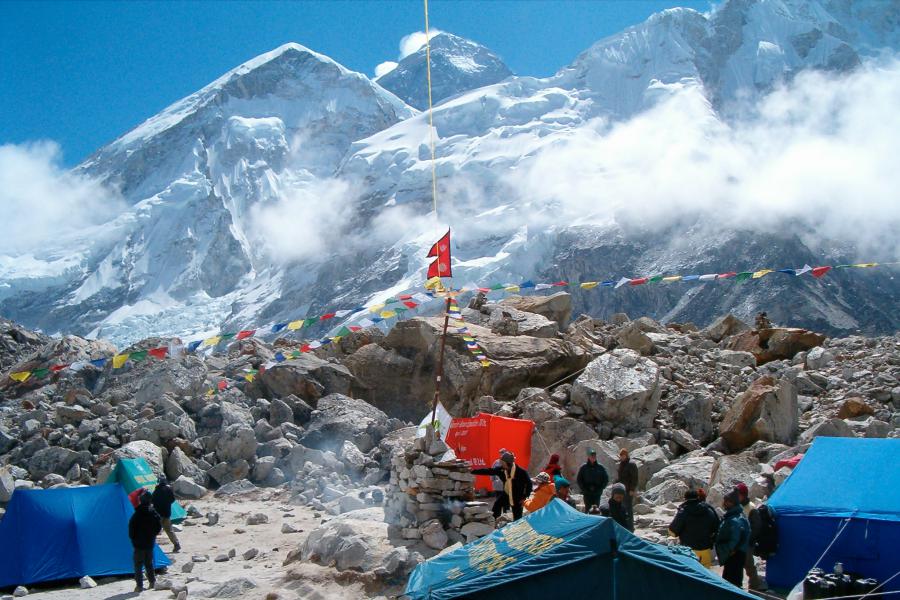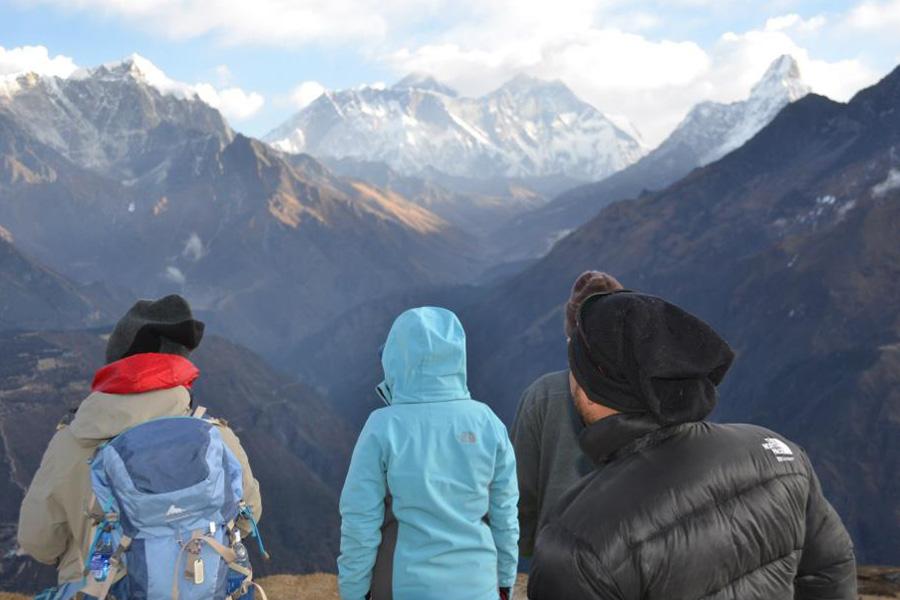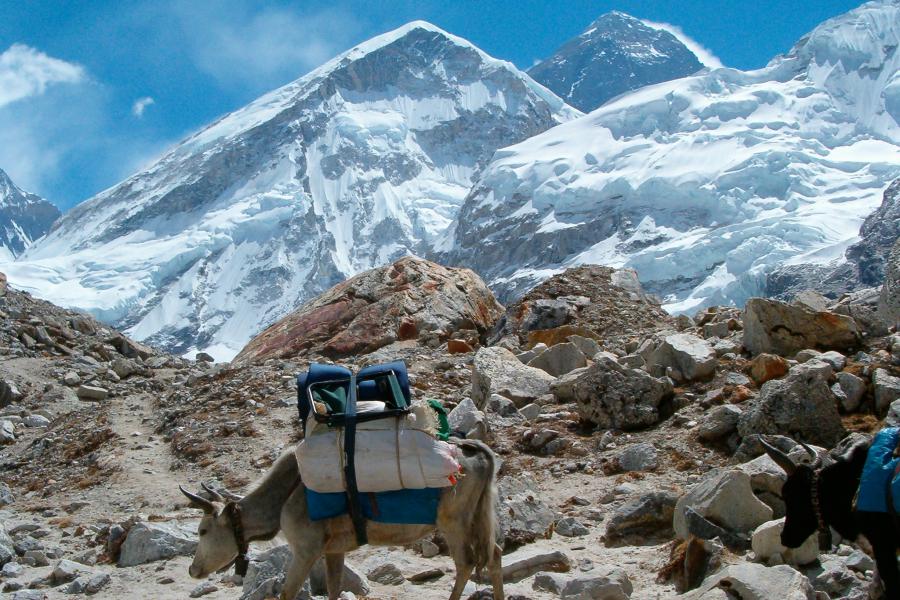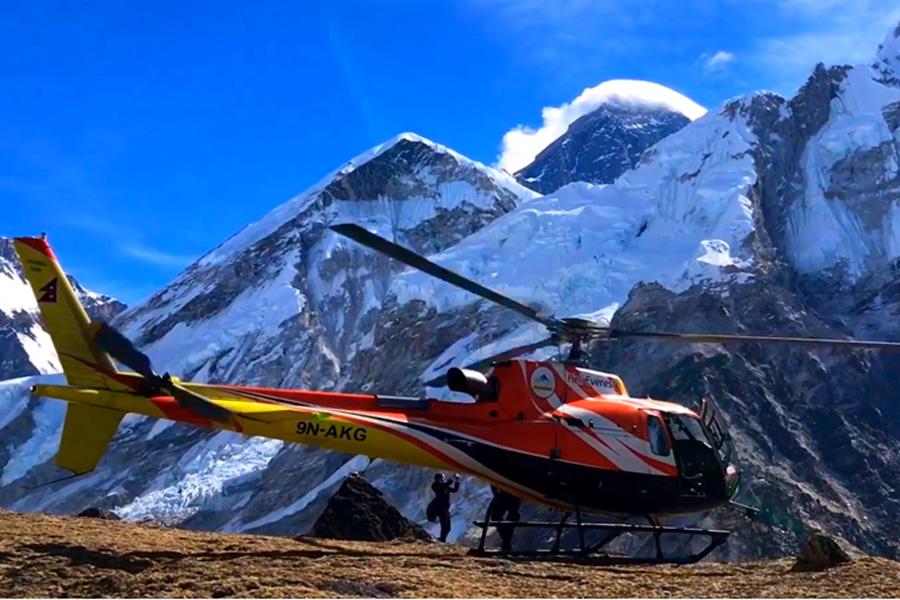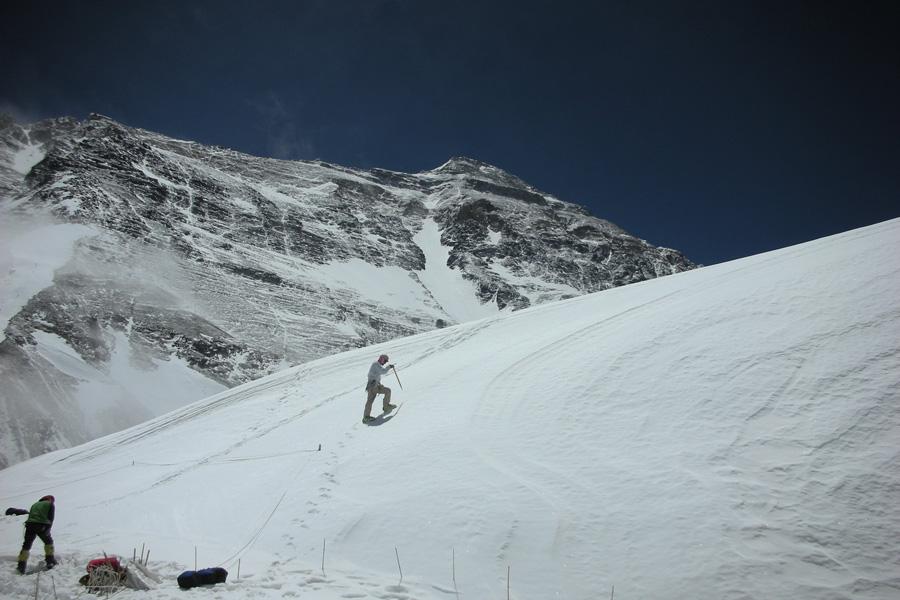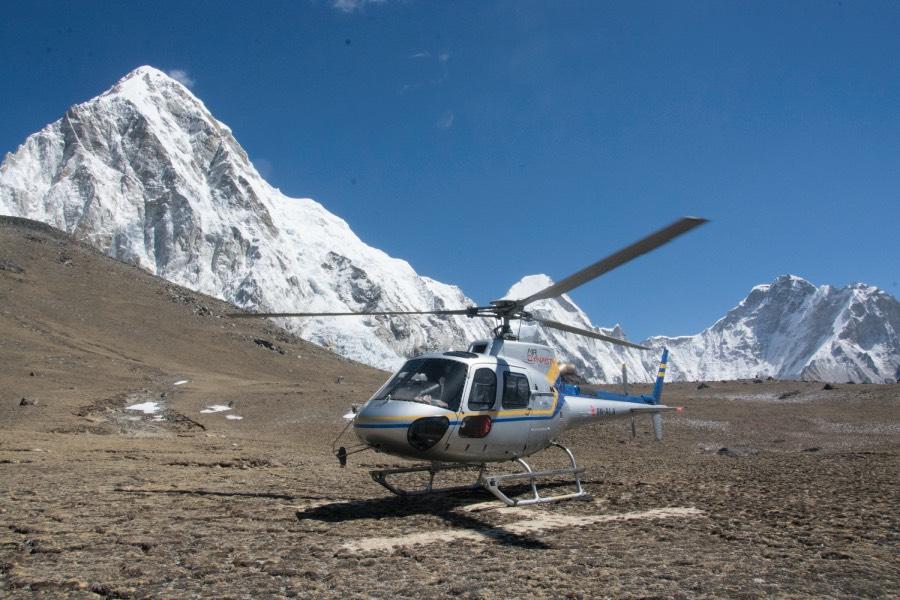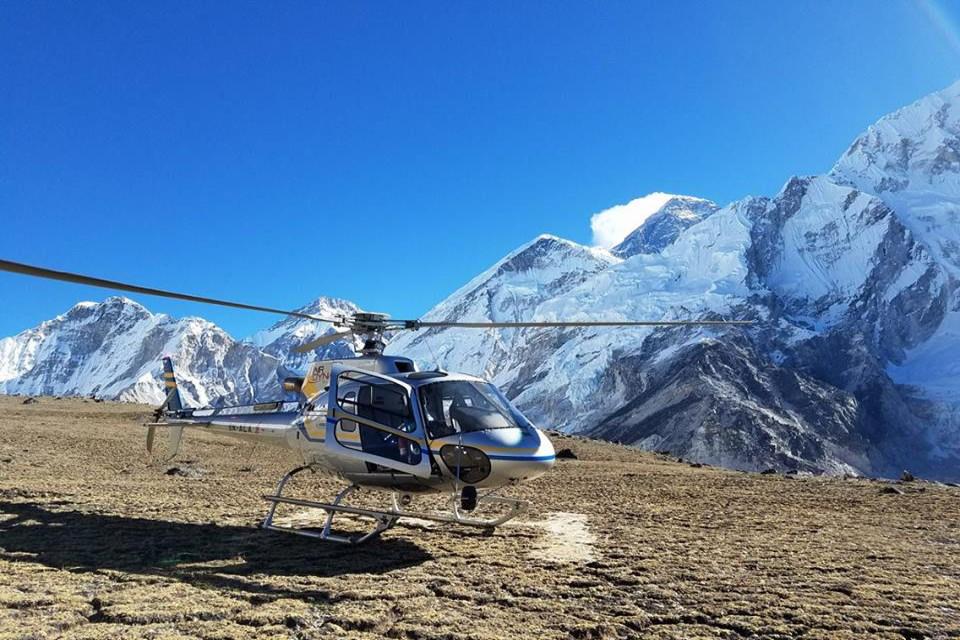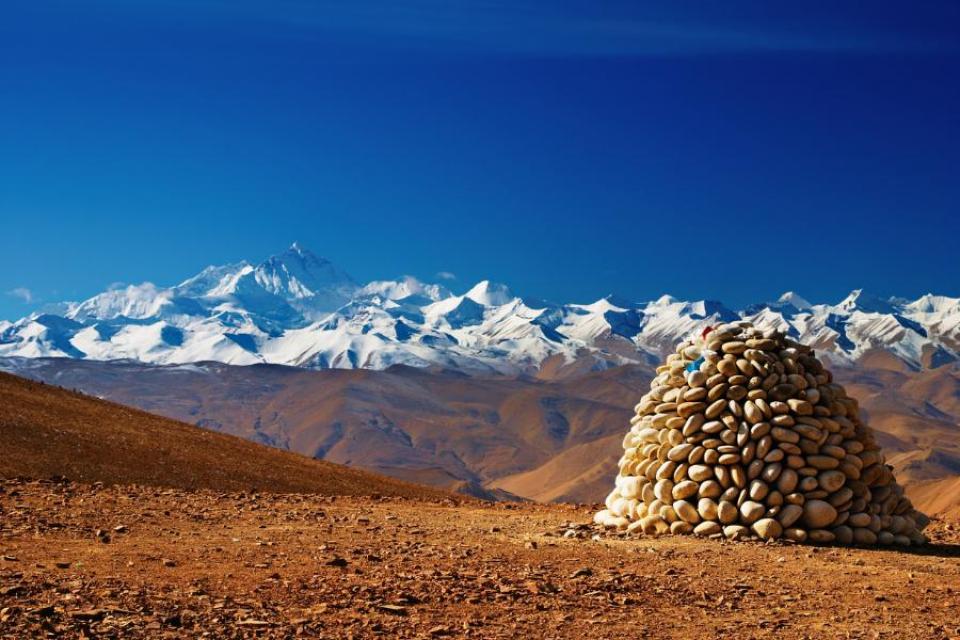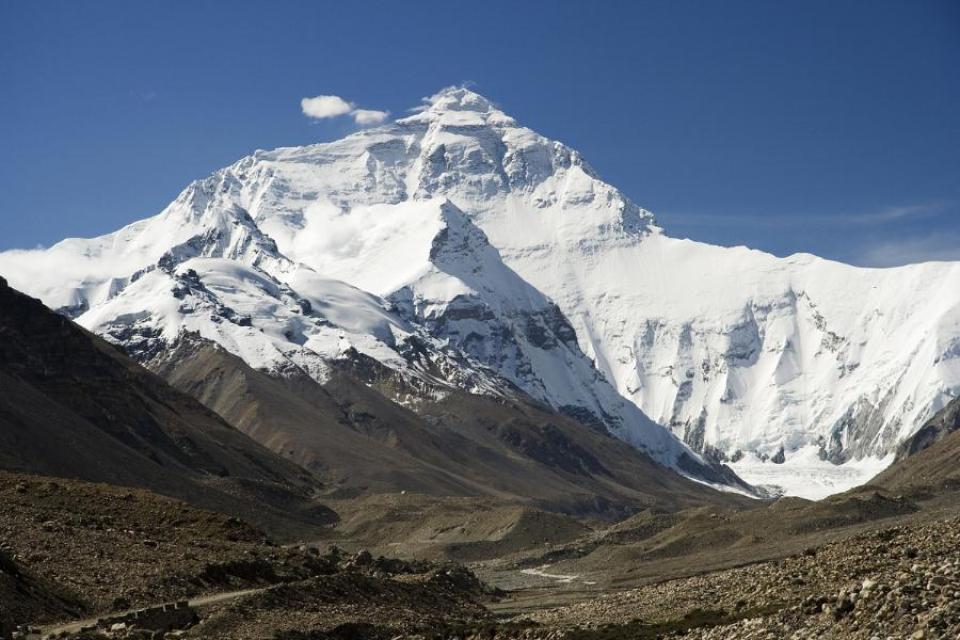Overview
The Everest Base Camp Trek is one of the most popular trekking routes in the world. It offers trekkers a chance to explore the stunning landscapes of the Himalayas and get close to Mount Everest, the tallest peak on Earth. It starts from the small airport in Lukla. The trekkers pass through picturesque Sherpa villages, lush forests, and rocky terrains before reaching Everest Base Camp at an altitude of 5,364 meters (17,598 feet). Along the way, trekkers experience breathtaking views of iconic peaks like Mount Everest, Lhotse, Nuptse, and Ama Dablam, making the journey a truly unforgettable adventure.
This Everest base camp trek guide also delves into the trek's unique blend of natural beauty and cultural significance. As trekkers make their way up, they pass through traditional Sherpa villages where they can learn about the rich customs, hospitality, and spiritual practices of the local people. The route is dotted with Buddhist monasteries, such as the renowned Tengboche Monastery, where trekkers can gain insight into the region's deep Buddhist heritage. The trek also provides an opportunity to witness the Sherpas' reverence for the mountains, seeing Everest as a sacred place and a connection to the divine.
For those following this Everest base camp trek guide, the journey unveils breathtaking natural wonders. Trekking in the Khumbu region leads adventurers through rugged landscapes, featuring glaciers, icefalls, and moraines. The journey ends at Kala Patthar, offering panoramic views of Mount Everest and its majestic surrounding peaks. The trek is not just a physical challenge, but a deeply spiritual experience as trekkers connect with the pristine natural environment and the sacred land of the Sherpa people.
The Everest Base Camp Trek, as outlined in this comprehensive guide, is a journey that blends adventure, culture, and natural beauty in a way that few other treks can match.
Highlights for Everest Base Camp Trek
1. Stunning Views of Mount Everest:
Trekkers are rewarded with breathtaking views of Mount Everest from EBC, along with surrounding peaks like Lhotse and Nuptse, especially from the Kala Patthar viewpoint.
2. Sherpa Culture and Hospitality During EBC Trek:
You can experience the rich Sherpa culture on the EBC trek as you pass through villages like Namche Bazaar, Dingboche, and Phortse and interact with the friendly Sherpa people.
3. Visit Buddhist Monasteries:
Explore historic Buddhist monasteries, including the famous Tengboche Monastery, and experience the spiritual significance of the region.
4. Panoramic views from Kala Patthar at EBC:
Kala Patthar offers one of the most iconic views of Everest and other surrounding peaks which makes it a top highlight of the trek.
5. Scenic Landscapes and Natural Beauty in Everest Region:
Trek through diverse landscapes, including lush forests, alpine meadows, and rocky moraines, offering stunning vistas along the way.
6. Khumbu Icefall and Glaciers:
Witness the massive Khumbu Icefall near Everest Base Camp, featuring shifting ice blocks, crevasses, and glaciers.
7. Challenging High-Altitude Terrain:
Navigate rugged terrain, with varying altitudes that provide a sense of adventure and accomplishment upon reaching Base Camp.
8. Interaction with Local Communities:
Visit traditional Sherpa villages and enjoy the local culture, food, and hospitality, enriching the overall trekking experience.
14-Day Outline Everest Base Camp Trek Itinerary
Day 1: Fly to Lukla, trek to Phakding.
Day 2: Trek to Namche Bazaar.
Day 3: Acclimatization day at Namche (short hikes).
Day 4: Trek to Tengboche.
Day 5: Trek to Dingboche.
Day 6: Acclimatization day at Dingboche (short hikes).
Day 7: Trek to Lobuche.
Day 8: Trek to Gorak Shep and visit Everest Base Camp.
Day 9: Hike to Kala Patthar, trek back to Pheriche.
Day 10: Trek to Namche Bazaar.
Day 11: Trek to Lukla.
Day 12: Fly back to Kathmandu.
Day 13: Buffer day in Kathmandu (optional).
Day 14: Departure.
Note: This plan allows for proper acclimatization and maximizes the trekking experience. Hence, itinerary can be changed according to your needs and preferences.
Everest Base Camp Trek Permits and Documentation
Here are the permits and documentation required for the Everest Base Camp trek:
Permits Required for EBC Trek:
To trek to Everest Base Camp (EBC), you need a Sagarmatha National Park Entry Permit and a Khumbu Pasang Lhamu Rural Municipality Entrance Permit. You may also need a Gaurishankar Conservation Area Permit if you're taking the Jiri route.
1. Sagarmatha National Park Entry Permit:
- This permit is required to visit the Everest region. You can get this permit in Kathmandu or Monjo. The Sagarmatha National Park Entry Permit for the Everest Base Camp (EBC) trek costs NPR 3,000 (approximately USD 25) for foreigners. The cost includes 13% VAT.
Who pays what?
- Foreigners: Pay NPR 3,000 per person
- SAARC nationals: Pay NPR 1,500 per person
- Nepalese: Pay NPR 100 per person
2. Khumbu Pasang Lhamu Rural Municipality Entrance Permit:
- A local permit that's required to enter the Khumbu region of Nepal. You can get this permit in Lukla.
- The Everest Base Camp (EBC) trek costs NPR 2,000 (approximately USD 20) for the first four weeks. After four weeks, the cost increases to NPR 2,500 per person.
3. Gaurishankar Conservation Area Permit:
- This permit is required only if you're taking the Jiri route to EBC. You'll need this permit because the Jiri route crosses the Gaurishankar Conservation Area.
- The entrance fee for the Gaurishankar Conservation Area is 3,000 rupees ($30). This is an optional permit for the Everest Base Camp (EBC) trek.
Documentation Needed for EBC Trek:
- Passport and Visa
- Proof of EBC Trek Travel Insurance
- Photocopies of Important Documents
- Emergency Contact Information
Best Time for Everest Base Camp Trek
1. Spring (March to May):
- Weather: Mild temperatures (10°C to 15°C at lower altitudes, -10°C to -5°C at EBC), clear skies, and stable weather.
- Best for: Popular due to pleasant weather and great visibility.
- Gear: Light layers, warm jacket, trekking boots, sunscreen, sunglasses, and a sleeping bag rated for -10°C.
2. Autumn (September to November):
- Weather: Cool temperatures (10°C to 15°C at lower altitudes, -10°C at EBC), clear skies, and stable weather.
- Best for: Great views and fewer crowds compared to Spring.
- Gear: Warm layers, insulated jacket, sturdy boots, sleeping bag rated for -10°C, and a warm hat and gloves.
Summer and Autumn season offer ideal conditions for trekking at EBC, with Spring being more popular and Autumn offering quieter trails. EBC weather conditions in Winter (December to February) are not ideal for trekking due to freezing temperatures, heavy snow, and strong winds. The trails become more dangerous, and many teahouses close, limiting accommodation and supplies. The risk of altitude sickness and slippery conditions also make it a hazardous time to trek.
Everest Base Camp Trek Distance:
The Everest Base Camp trek distance is approximately 130 kilometres. It's a 12 to 14 day trek with 5-8 hours of trek daily with your heavy backpacks. Trekkers are requested to walk slowly and take rest by acclimating with the weather of higher altitude as it rises with the trek to avoid altitude sickness. The Everest Base Camp trekking route requires careful planning to manage the challenging terrain and ensure a safe, enjoyable experience.
Here’s a breakdown of total distance to be covered during your trek at EBC:
- Kathmandu to Lukla - 135 km(by air)
- Lukla to Phakding: 7.8 km(trek starts)
- Phakding to Namche Bazaar: 10.7 km
- Namche Bazaar to Tengboche: 9.8 km
- Tengboche to Dingboche: 10 km
- Dingboche to Lobuche: 7.4 km
- Lobuche to Gorak shep: 4.5 km
- Gorak shep to Everest Base Camp: 4.1 km
Note: The total distance from Kathmandu to Everest Base camp is 200 km and will take you a total of 400 km for a round trip.
Alternative Route Distance for Everest:
- Kathmandu to Jiri - 190 kilometres(by road)
- Jiri to Salleri - 70km(by road)
- Salleri to Lukla - 40-50(trek starts)
- Lukla to Phakding: 7.8 km
- Phakding to Namche Bazaar: 10.7 km
- Namche Bazaar to Tengboche: 9.8 km
- Tengboche to Dingboche: 10 km
- Dingboche to Lobuche: 7.4 km
- Lobuche to Gorak shep: 4.5 km
- Gorak shep to Everest Base Camp: 4.1 km
Note: The total distance from Kathmandu to Everest Base Camp is approximately 370 to 380 kilometres via roads.
Cost of Everest Base Camp Trek
- Total Cost: $1,200 to $2,000 USD (depending on trek style and services).
- Permits: Around $50 to $80 for necessary trekking permits.
- Accommodation: $10 to $30 per night at tea houses along the trail.
- Food: $15 to $25 per day, depending on meals ordered.
- Guide/Porter: $20 to $30 per day for a guide, $15 to $20 for a porter.
- Transportation: Flights to Lukla (round-trip) cost around $300 to $400.
- Gear Rental: $50 to $100 for renting trekking gear like sleeping bags and jackets.
- Other Expenses: Travel insurance, tips for guides and porters, and personal items may add additional costs.
Accommodation on Everest Base Camp Trek
Below is the list of accommodations that you stay during your trek:
- Teahouses: The main form of accommodation along the trek, offers basic lodging and meals for trekkers.
- Room Conditions: The rooms are simple with a bed, blankets, and sometimes a small table; shared bathrooms are common.
- Variation in Quality: Accommodation is more comfortable in towns like Namche Bazaar and Lukla, while teahouses become more basic as you ascend to higher altitudes.
- Shared Facilities: Bathrooms are usually shared, and hot showers may be available at additional cost, especially at lower altitudes.
- Dining: Teahouses offer meals like dal bhat, noodles, and soups, providing energy for the trek.
- Cost: Prices increase as you ascend, with higher costs in remote areas due to difficult living conditions.
- Booking: It’s advisable to book ahead during peak seasons, as teahouses can fill up quickly, especially at higher altitudes.
Preparation for Everest Base Camp Trek:
Preparing for Everest Base Camp trek involves several important steps for safe and enjoyable trek. Here are some key points for preparations:
- Physical Training: Start physical training before a few months which includes hiking, running, cycling, swimming, weight lifting etc to develop cardiovascular endurance, strength and flexibility.
- Permits: Ensure you have all the required permits including Sagarmatha National Park Permit, Khumbu Pasang Lhamu Rural Municipality Permit and Gaurishankar Conservation Area Permit which is only for trekkers travelling from Jiri.
- Mental Preparation: Mental preparation is preparing yourself for every condition during the trek. Keep your mind calm and avoid panicking when situations arrive suddenly which need to be dealt with. Always be prepared for the worst case scenarios with a positive mindset.
- Acclimatisation: Acclimatisation is the crucial part of the trek. Trekkers need to rest to allow your body to gradually to the changing in weather altitude
- Gears and Equipment: Investment should be done in high-quality trekking gears which include waterproof and breathable clothing, comfy and high-quality trekking-boots, trekking sticks,a good quality backpack. And have proper accessories like sunglasses, hats etc.
- Health and Safety: Consult with a healthcare advisor about altitude sickness to ensure your safety. Carry a first aid kid with all kinds of possible tablets you may need during your trek.
Trekking Difficulty and Challenges
The trek’s difficulty and challenges for Everest Base Camp are as follows:
- Altitude: Trekking to high altitudes (5,364 meters at EBC) increases the risk of altitude sickness. Proper acclimatization is crucial.
- Steep Terrain: The trek involves steep ascents and descents, especially when crossing high mountain passes and navigating rocky trails.
- Weather Conditions: Unpredictable weather with strong winds, snow, and sudden temperature changes, especially during the colder months.
- Physical Endurance: The trek requires a good level of physical fitness due to long hours of walking on rugged terrain.
- Limited Facilities: Basic accommodations and limited access to medical services in remote areas can make the trek challenging.
- Trekking in Isolation: Limited communication and emergency support, especially on the higher parts of the trail, increase the difficulty.
- Mental Toughness: Long days, physical strain, and unpredictable conditions demand strong mental resilience from trekkers.
Trekking Gears and Equipments
Packing for the Everest Base Camp trek is one of the most crucial aspects to ensure a comfortable and successful journey. You should focus on packing only the necessary items, avoiding unnecessary weight, as it will make your trek easier and more enjoyable. The packing list for EBC include the following equipments and gears:
1. Clothing:
- Thermal tops and bottoms for base layers
- Fleece or down jacket for warmth
- Waterproof and windproof jackets and pants
- Lightweight windproof as well as waterproof trekking pants
- Insulated and windproof gloves
- Warm hat for cold weather
- Footwear like waterproof trekking shoes and sandals
- Extra pairs of warm socks
2. Gear:
- Trekking Bag up to 30-40 litres
- Sleeping Bag
- First-aid kit
- Trekking stick
- Water bottles
- Powerbank and multiple batteries
- Flashlight/Headlight
- Sunglasses to protect from uv rays of sun
3. Personal Items:
- Toiletries includes toothpaste,toothbrush,soap,shampoo,wet wipes etc
- Camera/Smartphone
- Quick Dry or lightweight towel
- Sunscreen
- Lip balm
- Travel documents include passport, permits and insurance
- Cash for donations in tea shops
4. Food and Snacks:
- Energy bars, energy supplements, electrolyte tablets
5. Optional Items:
- Earphones
- Gaiters
Cultural Experiences and Local Interactions
Everest base camp is inhabited by the Sherpa community, rich in culture with their exquisite heart welcoming hospitality. They celebrate festivals like Dumje, Mani Rimdu, Lhosar, Saga Dawa, Lhosar thung kar etc. Among them Mani Rimdu is one of their main festivals which is believed that Guru Rinpoche (Padmasambhava) brought Buddhism to Tibet and the Himalayas.This festivals last for several days of rituals and ceremonies with their cultural dances bringing all the sherpas together from different villages.
While trekking through the trails of EBC, you can see the colorful flags along the trails, especially on high passes, bridges, and near monasteries. The different colors of flags represent different meanings, like red for fire, green for water, blue for sky, white for air, and yellow for earth. You can see the Mani stones and walls along the trails carved with the sacred mantra called “Om mani padme hum.” It says that you should walk through the left side of the walls to show respect to their ancestors. Also, it brings bad luck to those walking to the right side of the walls.
EBC Trek Fitness Requirements:
Here are some of the necessary fitness requirements for EBC trek:
-
Physical Endurance: Trekkers should be in good physical condition, as the trek involves long days of walking (5-8 hours) on varied terrain.
-
Cardio Fitness: Cardiovascular fitness is essential, as you'll be trekking at high altitudes, and good stamina helps with prolonged exertion.
-
Leg Strength: Strong legs are important for climbing uphill and navigating rough trails, especially in higher altitudes.
-
Acclimatization Readiness: The ability to adjust to altitude changes is key to altitude sickness, so conditioning helps with acclimatization.
-
Mental Stamina: Mental strength is vital for overcoming fatigue and staying motivated throughout the challenging trek.
-
Regular Training: Start preparing 2-3 months before your trek with hiking, cardio, and strength training to build endurance and prepare for high-altitude trekking.
Acclimatisation Tips for Everest Base Camp Trek:
- Ascend Slowly: Trekking guidelines should not be more than 300-500 metres. Ascend slowly with the rise in altitude to acclimatise with weather.
- Eat balanced diet: Eat food which is rich in carbohydrates, fibre and energy giving food to strengthen your energy level.
- Layering of clothes: Layering of clothes helps to keep your body warm and there’ll be less chances of getting cold which may decrease the pace of the trek.
- Climb high and sleep low: While trekking to higher altitude you should trek to higher altitude slowly but come back to sleep at a lower altitude. Take a walk to be familiarised with the weather and the altitude.
- Stay hydrated: Always drink plenty of water to keep yourself hydrated which helps to avoid altitude sickness.
- Avoid alcohol and narcotics: This may help you to save your energy as these things can contain all your energy and make you weak for the trek.
Note: These acclimatisation tips help prevent altitude sickness, which can be a serious risk during the Everest Base Camp trek.
Safety Tips for Everest Base Camp Trek
Health and Safety Considerations for Everest Base Camp Trek are given below:
- Bring Lightweight Snacks: Carry your favorite snacks as higher altitudes increase snack prices, and some items may not be available in mountain areas.
- Cash and Payments: Bring enough cash, as ATMs are only available in Namche Bazaar. Online payment options and card payments may only be possible in towns and come with high fees.
- Power Banks and Solar Chargers: Ensure you have power banks or solar-powered batteries to charge devices like phones and cameras, as power sources are limited.
- Wet Wipes and Hand Sanitizer: Bring wet wipes for hygiene, as water may not be available at all places. Hand sanitizer is crucial to prevent infections and stomach issues.
- Stay Energized: Eat plenty of food and snacks for energy, as trekking requires a lot of physical effort.
- Hydration: Drink plenty of water to stay hydrated throughout the trek, which helps prevent fatigue and altitude sickness.
- Acclimatization: Take it slow, rest, and acclimatize to avoid altitude sickness. Avoid rushing and listen to your body for a safe trek.
- Indoor Games: Bring light indoor games like UNO or cards to entertain yourself during downtime at lodges or hotels.
Sustainable and Responsible Tourism
- Respect Nature: Stay on marked trails, avoid littering, and carry out all your trash.
- Respect Local Culture: Be mindful of local customs and ask permission before photographing people or religious sites.
- Use Eco-friendly Products: Eco-friendly trekking in Himalayas should be done to avoid plastic, carry a reusable water bottle, and use biodegradable toiletries.
- Support Local Businesses: Stay in local teahouses and hire local guides to help the community.
- Participate in Clean-ups: Join initiatives to clean up waste and follow the Leave No Trace principles.
- Travel Off-Peak: Trek during quieter seasons to reduce overcrowding and minimize environmental strain.
Conclusion
The Everest Base Camp trek guide offers a unique adventure with stunning views of the Himalayas, including the Khumbu Glacier and Icefall, while immersing trekkers in the Sherpa culture. This guide emphasizes the importance of proper acclimatization, careful planning, and the right gear to ensure a successful and safe trek.
As you follow this Everest base camp trek guide, it's crucial to trek responsibly by respecting the environment and local culture. Practice sustainable tourism by minimizing your impact, supporting local businesses, and following the Leave No Trace principles. By preparing adequately and trekking with respect, you can not only enjoy the adventure but also contribute to the preservation of this majestic region for future generations. So, plan ahead, embrace the challenges, and let the adventure of a lifetime begin!
Author: Samaiksha kalyan Tharu
Date: 24th December, 2024
Related Trip


